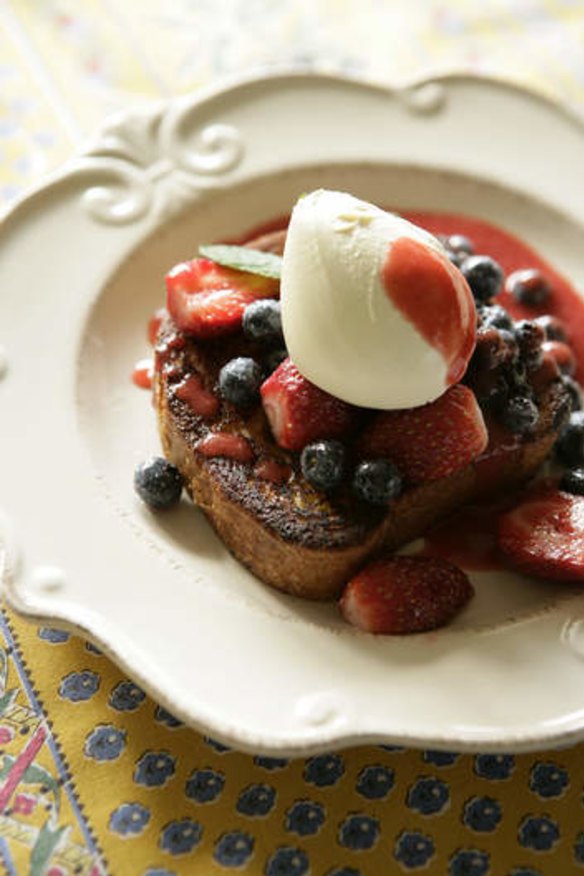What is creme fraiche?

What is creme fraiche? Is it the same as sour cream? S. McGrath
For this question, we had to travel to Myrtleford in Victoria, where an artisan producer of cultured butter lives. Naomi Ingleton, of the Butter Factory, also makes creme fraiche and had a batch ready for us to try when we arrived.
It was like a thick and spreadable cream that had a delicious cheesy and mushroomy aroma, but was wonderfully tangy. She explained that she had introduced a mixture of cultures, including lactobacillus. These are bugs that eat the sugar and in return produce lactic acid, which coagulates the protein in the cream, thickening the texture. Creme fraiche also has different moulds that give it its rich and delicious aroma and flavour.
Sour cream, on the other hand, is simply cream that is soured by the addition of lactobacillus. The key difference for cooks is that sour cream typically has a lower fat content than creme fraiche and may be further thickened with gelatin, which means sour cream may curdle when added to hot liquid, whereas creme fraiche can be used in cooking without splitting. Creme fraiche goes well with salmon and soups. Sour cream is good for children's nachos and creamy mashed potatoes.
Should I trim off the feathery green carrot tops? B. Clarke
Here's a QI moment for you. In the 1600s, wild carrot tops were a fashionable headdress. Here's another fact for you, one that might appal vegetable lovers: carrots don't die when you pull them from the ground. They live on, stuffed inside the plastic bag in your cold, dark crisper. So sad.
As they continue on towards their eventual demise in your salad, crudites or soup, the leaves continue to transevaporate, which means moisture from the root and leaves continues to evaporate out of the tiny holes on the underside of the leaves. So take the leaves off and the carrots will stay crisp longer. If you do find yourself with a limp carrot, drop it into a sink of icy cold water for 30 minutes or so and it should become firm again.
I like cooking Indian food, but I am having trouble finding ghee. What can I use instead? H. Knight
Do you remember that delightful children's book with the appallingly racist title Little Black Sambo? Sambo had a new outfit, but was bullied out of it by tigers who wanted to wear his clothes. The tigers were all so jealous of each other that they chased each other around a palm tree so fast they turned into ghee. Now, ghee is not made from tigers. They are made into aphrodisiacs.
Ghee is a style of clarified butter. Butter is about 85 per cent fat and 15 per cent liquid, which is mostly water with proteins, sugar and minerals suspended or dissolved in it. Fry butter and the proteins and sugar burn. Melt butter very gently, however, and the butterfat separates and floats to the top.
You can pour this into a fat-separating jug with a hole for the spout in the bottom and pour the water away. If you don't have one of these, you can try to pour off the butterfat, or you can do what I have seen done before and put a hole in the bottom of a yoghurt container, cover it with your finger and pour in the warm, melted butter.
Allow the fat to rise, then remove your finger and let the water pour away. What you are left with is clarified butter and, while it is not exactly ghee, you can use it in the same manner.
What causes the little holes to form in aluminium foil? E. Mentz
Electricity. When you cover acidic food with aluminium foil and the food is in a cast-iron or stainless-steel pan, for example, acid in the food conducts electrons from the aluminium to the steel or iron. It's like a very low-powered battery.
To avoid this, use a glass, plastic or ceramic vessel. This effect won't happen if you use an aluminium tray, because the same metal won't give up electrons to itself. On aluminium foil, how many people know there is a shiny side and a dull side? The dull side transfers twice as much heat as the shiny side, which reflects radiant heat. So if you want to protect food from burning in the oven, such as the bones of a rack of lamb or the crust of a tart, face the shiny side out. If you want to let more heat reach the food, perhaps a baked potato, face the dull side out.
If you want it to protect your head from CIA mind-control signals, seek professional help.
If you have a query, email brainfood@richardcornish.com.au
The best recipes from Australia's leading chefs straight to your inbox.
Sign up- More:
- Brain food
